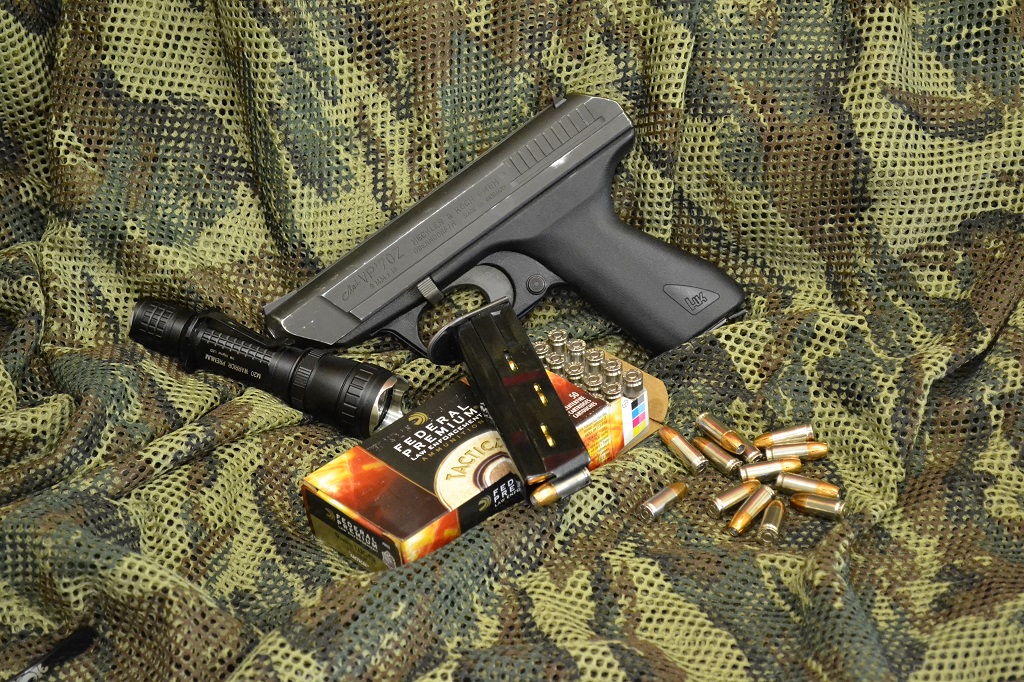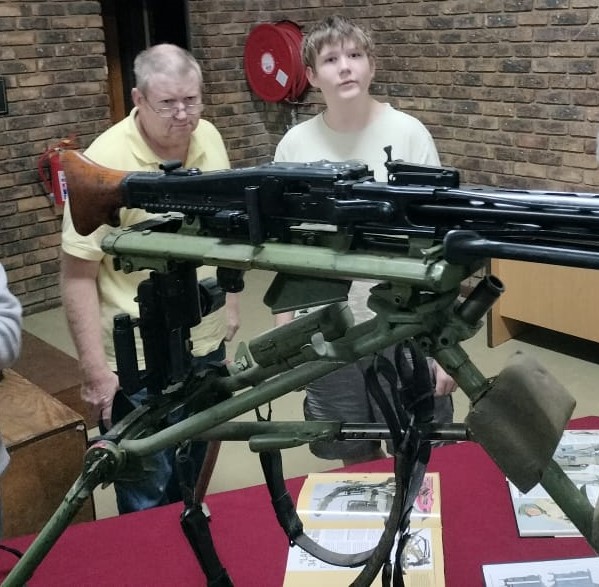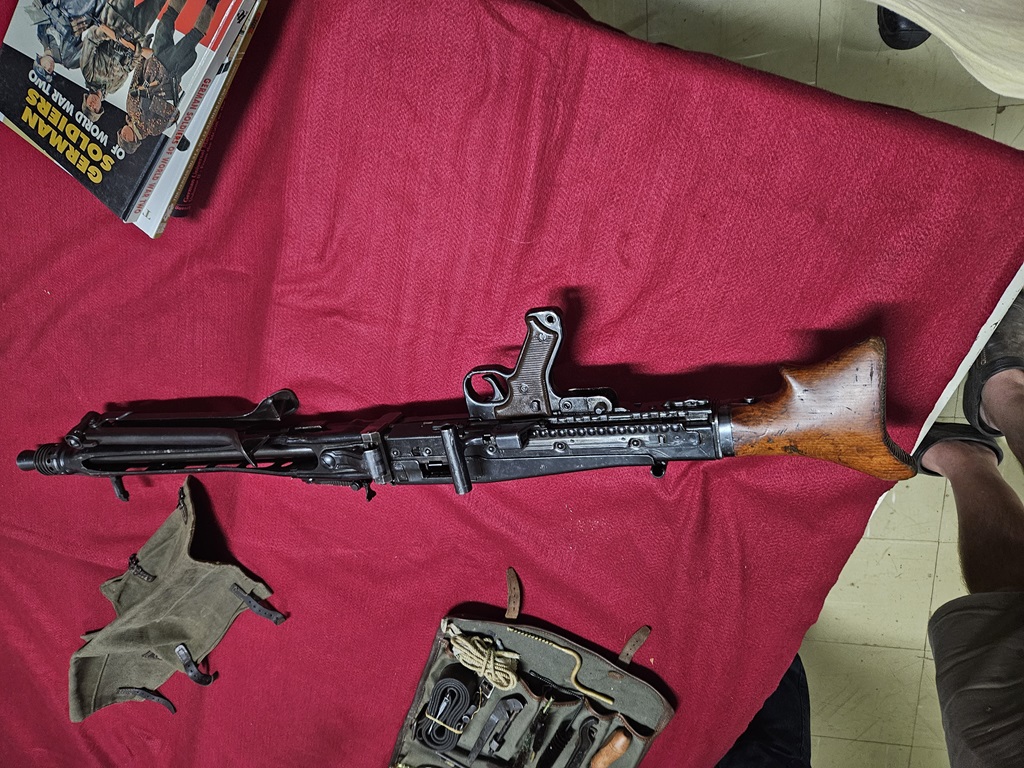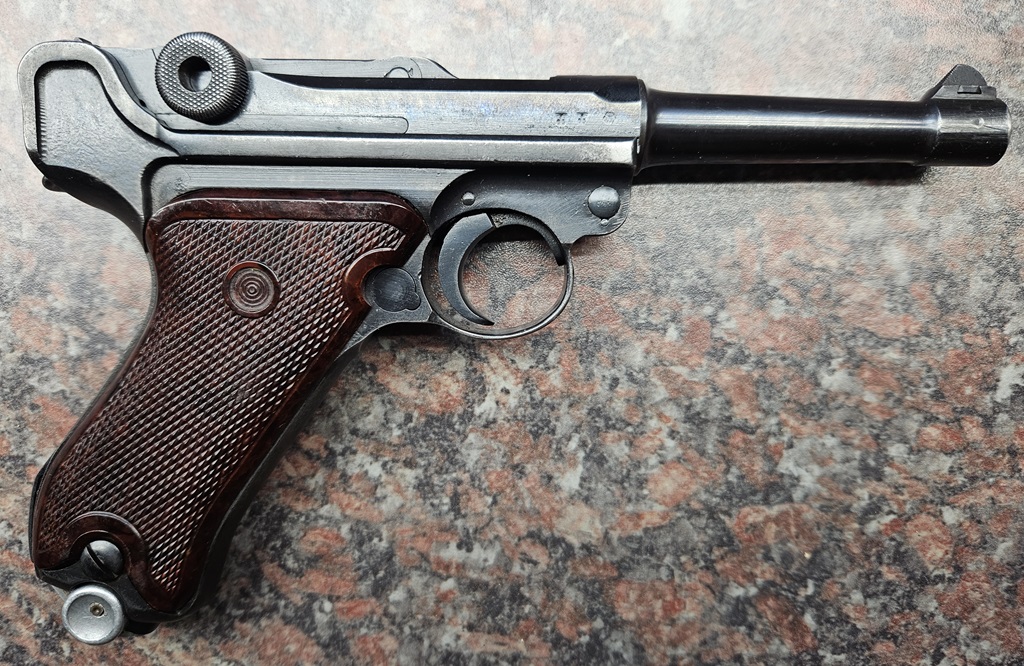- Welcome to Allgunstuff Forum.
Recent posts
#21
Alloys and Composition / Re: Altered wheel weight compo...
Last post by troglodyte - May 09, 2024, 06:33 PMQuote from: Krazong on May 08, 2024, 08:03 PMI find that the stick-on wheel weights which are actually made of lead (Pb) can only be used for muzzle loaders. In fact, they are so soft that it's in fact almost pure 100% Lead. Because it's not really an alloy, it casts with great difficulty and does not flow as well as the crimp-on wheelwreights. You also would want to increase the temperature a lot to effectively cast a nice bullet without wrinkles. They made great roundballs and I use them exclusively to cast my .715" and .735" roundballs. These balls consume huge amounts of lead, being 550 and 650 grains respectively.*******************************
I was told the stick on weights are NOT pure lead, the need to be softer than lead and are therefore an alloy. I have believed this since forever,
I now actually researched it to correct your post only to find that the stick on weights I have been turning down are actually the real thing ..........................Waaaaaaaaa ha ha ha !
#22
Collector Firearms / H&K VP70z
Last post by Krazong - May 09, 2024, 03:37 PMFor those of you who love polymer made firearms and think that Glock was the first commercially available polymer framed gun, you are wrong.
The first polymer framed gun was actually the Remington Nylon 66 made in 1959 BUT this was in fact a rifle, not a handgun.
The very first commercially available handgun made with a polymer frame, was in fact the Heckler & Koch VP70.
This was manufactured back in 1970 and therefore predates the first Glock 17 gen 1 by about 12 years.

It was manufactured primarily for the police or military and it came in two variants.
VP70z was the "Zivil" or civilian version lacked the ability to add the shoulder stock extension to enable the three round automatic burst.
VP70m was the military variant and when mated with the shoulder stock, had the ability to fire a three round burst.
It was not widely accepted and one can argue that it was a commercial failure. The firearm was very innovative for it's period though but had some minor niggles which made it not very popular. The main drawback was the fact that it is a pure blowback type pistol, without any lockup mechanism used by most 9mmP chambered firearms. This caused some design limitations which include:
Very heavy slide to absorb recoil
Very deep grooves in the barrel to reduce pressure.
It also came with a unique front sight which did not work very well. It has two brightly polished posts and this caused a black "shadow" in between the posts which you need to align with the notched rear sight. The sights were not replaceable. It also does not have a slide lock on the last round fired. This is a problem as you might find that your gun goes "click" instead of "bang" unless you counted the rounds fired.
Similar to Glock. it was striker fired with no external safety. Unlike Glocks, the VP70 has a DAO trigger (Double Action Only) and the trigger is very heavy with every single shot fired, making accurate shots a challenge. It was very reliable though. Every shot fired had an "interesting" type of recoil due to the extremely heavy metal slide and the very stiff recoil spring. It is also fairly big but does have an 18 round double stack, double feed magazine. Loading the magazine can be done in a similar way to an Uzi where the rounds are simply pushed straight down into the magazine.
Overall, an interesting collectors gun with a very prominent place in history.
The first polymer framed gun was actually the Remington Nylon 66 made in 1959 BUT this was in fact a rifle, not a handgun.
The very first commercially available handgun made with a polymer frame, was in fact the Heckler & Koch VP70.
This was manufactured back in 1970 and therefore predates the first Glock 17 gen 1 by about 12 years.

It was manufactured primarily for the police or military and it came in two variants.
VP70z was the "Zivil" or civilian version lacked the ability to add the shoulder stock extension to enable the three round automatic burst.
VP70m was the military variant and when mated with the shoulder stock, had the ability to fire a three round burst.
It was not widely accepted and one can argue that it was a commercial failure. The firearm was very innovative for it's period though but had some minor niggles which made it not very popular. The main drawback was the fact that it is a pure blowback type pistol, without any lockup mechanism used by most 9mmP chambered firearms. This caused some design limitations which include:
Very heavy slide to absorb recoil
Very deep grooves in the barrel to reduce pressure.
It also came with a unique front sight which did not work very well. It has two brightly polished posts and this caused a black "shadow" in between the posts which you need to align with the notched rear sight. The sights were not replaceable. It also does not have a slide lock on the last round fired. This is a problem as you might find that your gun goes "click" instead of "bang" unless you counted the rounds fired.
Similar to Glock. it was striker fired with no external safety. Unlike Glocks, the VP70 has a DAO trigger (Double Action Only) and the trigger is very heavy with every single shot fired, making accurate shots a challenge. It was very reliable though. Every shot fired had an "interesting" type of recoil due to the extremely heavy metal slide and the very stiff recoil spring. It is also fairly big but does have an 18 round double stack, double feed magazine. Loading the magazine can be done in a similar way to an Uzi where the rounds are simply pushed straight down into the magazine.
Overall, an interesting collectors gun with a very prominent place in history.
#23
Reloading Methodology / Re: Doppies inskiet / fireform...
Last post by Krazong - May 09, 2024, 02:59 PMI used to do some fire forming with my 7x57 using a load of 10 grains MP200 and adding some tissue paper on top of that. Filled with mielie meel, and then held into place with another wad of toilet paper. Must be shot on a shooting range at it's nearly as loud as a real bullet. Difficult to clean the barrel afterward and smells like burnt pap.
#24
Collector Associations / Re: So, you want to become a c...
Last post by oafpatroll - May 09, 2024, 12:16 PMThanks, most interesting. If my toy budget was in better shape or had realistic prospects of improvement collecting would be something I'd love to explore. As a military history geek there are very few artifacts that are of more interest to me than the firearms used in the conflicts of the periods I'm interested in.
#25
Collector Associations / Re: So, you want to become a c...
Last post by big5ifty - May 09, 2024, 12:10 PMThank you for taking the time to share your knowledge and experience.
#26
Reloading Methodology / Doppies inskiet / fireform cas...
Last post by Ds J - May 09, 2024, 04:46 AMDie vraag is eenvoudig: watter metodes bestaan daar om doppies in te skiet, en hoe doen n mens dit?
The question is quite easy: which methods exist to foreform cases, and how is it done?
(Vir die Afrikaanse deelnemers: daar bestaan sover ek weet nie 'n geykte term vir "fireform" nie. Ek maak dus nou die begrip "doppies inskiet". Soos wat 'n mens n teleskoop met 'n sekere lading inskiet, moet doppies ook soms ingeskiet word om by 'n spesifieke geweer te pas.)
#27
Collector Associations / Re: So, you want to become a c...
Last post by BBCT - May 08, 2024, 11:26 PMNice summary Krazong! Couldn't have done it better myself. 

#28
Cast Bullet Coatings / Re: Powder coating is quick, e...
Last post by oafpatroll - May 08, 2024, 10:21 PMQuote from: Krazong on May 08, 2024, 05:38 PMI stand corrected then.
Maybe I should test my SWC cast bullets I use for my 38Spl in my 357 Mag and see if I still get decent accuracy.
Using cast lead I should gain an extra +- 100ft/sec compared to CMJ/FMJ. This implies a velocity of around 1900 ft/sec
Will test and report back.
My experience is that I require slightly less propellant to achieve book velocities for cast when powdercoating. Have to assume the stuff is slidier than raw lead.
#29
Alloys and Composition / Re: Altered wheel weight compo...
Last post by Krazong - May 08, 2024, 08:03 PMI find that the stick-on wheel weights which are actually made of lead (Pb) can only be used for muzzle loaders. In fact, they are so soft that it's in fact almost pure 100% Lead. Because it's not really an alloy, it casts with great difficulty and does not flow as well as the crimp-on wheelwreights. You also would want to increase the temperature a lot to effectively cast a nice bullet without wrinkles. They made great roundballs and I use them exclusively to cast my .715" and .735" roundballs. These balls consume huge amounts of lead, being 550 and 650 grains respectively.
#30
Collector Associations / So, you want to become a colle...
Last post by Krazong - May 08, 2024, 07:52 PMBecoming a firearms collector is not destined for everybody out there. If you want to become a firearm hoarder, where the emphasis is on quantity rather than quality or historical significance, then becoming a firearm collector is not for you. Rather get dedicated sport status and license your "lots-o-guns" that way.
Now don't get me wrong, I am a dedicated sport shooter myself and do not see anything wrong with sport shooters. In fact I personally think sport shooting will enhance your firearm skill level a lot if you are competitive and shoot a lot.
Your first step to becoming a firearms collector is to decide what type of guns you intend to collect. You can only collect firearms which falls into a specific "theme" Let's say for instance you like "Small arms used by the British during ww2", then this can be the perfect theme for you. There are a lot of different types of guns used by the British during that period. If you want to widen this theme, then think of "Small arms used by the Allied forces during WW2" or even "Small arms used during WW2" and include the Axis powers as well. Yes, you can also have multiple themes covering a myriad of countries and periods.
Before you can become a registered collector, you would have to apply for membership at any one of the accredited collectors associations out there. All of their membership requirements might differ slightly, but will work roughly the same way. As part of the membership, there will be a committee which will ask you some questions with regards to your chosen theme and field of interest. This is to see if you have at least some rudimentary knowledge about your chosen theme.
As a new potential member you will most likely only be approved as a category D collector. This means that you may add any semi automatic handgun, revolver, manually operated rifle or shotgun to your collection up to maximum numerical limit of (I think) 6 firearms. This is also normally the starting category for junior members which is not yet 21 years old but have a desire to own and start collection guns. Keep in mind that there is not a minimum age limit to become a collector. Approval of members are normally at the sole discretion of the collectors committee. All collectors are normally expected to grow their collection in time.
Once you have demonstrated your added value to the community of firearm collectors you can move up to category C status. This will remove the six firearm numerical limit. If you want to collect "restricted" firearms which include firearms like semi automatic shotguns and rifles, then you need to have category B status. Moving up in status might require approval from the committee and another verbal meeting with you. Catagory A status is required for "prohibited" firearms which include stuff like grenade launchers and fully automatic firearms. (expect a lot of safe inspections from the SAPS for cat A status)
Before we go further, it is not a requirement to have a "walk in safe" to become a collector. You also do not have to start off with a huge collection. Your collection also does not have to be expensive. If you have a passion for collecting "vest pocket pistols of the gangster era" then by all means go and collect Baby Browning / Colt vest pockets if you want. They are not all that expensive. Yes you can have multiple examples of the same type of gun in your collection.
Each firearm you intend to collect needs it's own S17 license. The collector firearm does not have to be de-activated and can be used any place where it is safe and legal to do so. This implies that you can legally go and shoot it at a shooting range. You are also legally allowed to hunt with your collector's firearm and should the need arise, you can also use it in a self defense scenario just like any other firearm. You may have some more explaining to do as to why you shot the intruder endangering your life with a .55" Boys anti tank rifle, but that's on you.
Your collectors association will need to endorse the firearm you intend to license before you can apply for a S17 application from the SAPS. This is done in the form of documentation you have to submit for your specific firearm, which will also double as the motivation as required by the SAPS for the application. This document is signed by the chairman of your association. This document will contain information as to how this firearm fits into your collection, history of said firearm, collectable properties etc.
Just like you have to maintain your dedicated sport status, you also need to be a "member in good standing" with your collector's association. This implies that you would have to attend a certain amount of meetings / functions / shoots / exhibitions from your collectors association every year. I personally find the functions from my own collectors association to be extremely informative and exciting. My son and I attended an information session about the MG42 in April 2024 and it was awesome!


I personally find it exciting to attend collector's meetings...
We collectors normally go for quality instead of quantity. Typical example is this P08 Luger below.


From the image we can deduct that it's in really good condition, not refinished with matching serial numbers all round. (ok ok, we would have to strip it to confirm matching serial numbers)
The documentation part of this application included the fact that it was made in 1938 and the S/42 marking was the code given to the Mauser factory during WW2 so that the allies would not know where this gun was made should it be captured. It was replaced by the Walther P38 due to the cost of manufacturing.
A lot of research needs to be done before you can apply for the firearm as a collector.
Us collectors normally don't refinish any firearms, but would rather keep it in it's original condition. An original 303 British Lee Enfield in original condition is worth a lot more (to me) than the same 303 fitted with a modern telescopic sight. If you can find the No.4 Mk.I* (T) variant, now that would indeed be a true collectors piece!
If you have any questions regarding the collector's process, feel free to post in this thread and I will attempt to answer to the best of my ability.
Now don't get me wrong, I am a dedicated sport shooter myself and do not see anything wrong with sport shooters. In fact I personally think sport shooting will enhance your firearm skill level a lot if you are competitive and shoot a lot.
Your first step to becoming a firearms collector is to decide what type of guns you intend to collect. You can only collect firearms which falls into a specific "theme" Let's say for instance you like "Small arms used by the British during ww2", then this can be the perfect theme for you. There are a lot of different types of guns used by the British during that period. If you want to widen this theme, then think of "Small arms used by the Allied forces during WW2" or even "Small arms used during WW2" and include the Axis powers as well. Yes, you can also have multiple themes covering a myriad of countries and periods.
Before you can become a registered collector, you would have to apply for membership at any one of the accredited collectors associations out there. All of their membership requirements might differ slightly, but will work roughly the same way. As part of the membership, there will be a committee which will ask you some questions with regards to your chosen theme and field of interest. This is to see if you have at least some rudimentary knowledge about your chosen theme.
As a new potential member you will most likely only be approved as a category D collector. This means that you may add any semi automatic handgun, revolver, manually operated rifle or shotgun to your collection up to maximum numerical limit of (I think) 6 firearms. This is also normally the starting category for junior members which is not yet 21 years old but have a desire to own and start collection guns. Keep in mind that there is not a minimum age limit to become a collector. Approval of members are normally at the sole discretion of the collectors committee. All collectors are normally expected to grow their collection in time.
Once you have demonstrated your added value to the community of firearm collectors you can move up to category C status. This will remove the six firearm numerical limit. If you want to collect "restricted" firearms which include firearms like semi automatic shotguns and rifles, then you need to have category B status. Moving up in status might require approval from the committee and another verbal meeting with you. Catagory A status is required for "prohibited" firearms which include stuff like grenade launchers and fully automatic firearms. (expect a lot of safe inspections from the SAPS for cat A status)
Before we go further, it is not a requirement to have a "walk in safe" to become a collector. You also do not have to start off with a huge collection. Your collection also does not have to be expensive. If you have a passion for collecting "vest pocket pistols of the gangster era" then by all means go and collect Baby Browning / Colt vest pockets if you want. They are not all that expensive. Yes you can have multiple examples of the same type of gun in your collection.
Each firearm you intend to collect needs it's own S17 license. The collector firearm does not have to be de-activated and can be used any place where it is safe and legal to do so. This implies that you can legally go and shoot it at a shooting range. You are also legally allowed to hunt with your collector's firearm and should the need arise, you can also use it in a self defense scenario just like any other firearm. You may have some more explaining to do as to why you shot the intruder endangering your life with a .55" Boys anti tank rifle, but that's on you.
Your collectors association will need to endorse the firearm you intend to license before you can apply for a S17 application from the SAPS. This is done in the form of documentation you have to submit for your specific firearm, which will also double as the motivation as required by the SAPS for the application. This document is signed by the chairman of your association. This document will contain information as to how this firearm fits into your collection, history of said firearm, collectable properties etc.
Just like you have to maintain your dedicated sport status, you also need to be a "member in good standing" with your collector's association. This implies that you would have to attend a certain amount of meetings / functions / shoots / exhibitions from your collectors association every year. I personally find the functions from my own collectors association to be extremely informative and exciting. My son and I attended an information session about the MG42 in April 2024 and it was awesome!


I personally find it exciting to attend collector's meetings...
We collectors normally go for quality instead of quantity. Typical example is this P08 Luger below.


From the image we can deduct that it's in really good condition, not refinished with matching serial numbers all round. (ok ok, we would have to strip it to confirm matching serial numbers)
The documentation part of this application included the fact that it was made in 1938 and the S/42 marking was the code given to the Mauser factory during WW2 so that the allies would not know where this gun was made should it be captured. It was replaced by the Walther P38 due to the cost of manufacturing.
A lot of research needs to be done before you can apply for the firearm as a collector.
Us collectors normally don't refinish any firearms, but would rather keep it in it's original condition. An original 303 British Lee Enfield in original condition is worth a lot more (to me) than the same 303 fitted with a modern telescopic sight. If you can find the No.4 Mk.I* (T) variant, now that would indeed be a true collectors piece!
If you have any questions regarding the collector's process, feel free to post in this thread and I will attempt to answer to the best of my ability.
